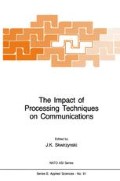Abstract
The advent of VLSI technology is opening up new possibilities in the realisation of efficient speech processing algorithms significantly more complex than the universally accepted PCM method.
At the same time it is stimulating a bewildering range of new coding techniques. This is bound to have a significant effect on future communication networks and standards.
Selected illustrations of processing techniques and their classification are presented, together with key parameters such as information rate, complexity, delay and quality.
Possible applications in various telecommunications applications such as modems, integrated digital networks, store and forward systems are discussed.
Access this chapter
Tax calculation will be finalised at checkout
Purchases are for personal use only
Preview
Unable to display preview. Download preview PDF.
References
J L Flanagan et al: ‘Speech Coding’, IEEE Trans on Com., 27, No 4, (1979) 710–737.
J N Holmes: ‘A survey of methods for digitally encoding speech signals’, The Radio and Elect Eng, Vol 52, No 6, (1982) 267–276.
A H Reeves: French Patent 852183, 1938
D J Dooley et al: ‘Aversati1e monolithc PCM codec’. Int Zurich Seminar on Digital Communications, Zurich 1976
H Dudley: ‘Remaking speech’. J Acoust Soc An., Vol 11, (1939) 169–177
N G Kingsbury et al: ‘A robust channel vocoder for adverse environments’, ICASSP ‘80, Denver.
M Yoshikawa et al: ‘Network applications of new speech encoding technologies’, GLOBECOM ‘82, Vol 1, A8.1.1-A8.1.5, 1982
D Coint of et al: ‘A 60-channel PCM-ADPCM converter robust to channel errors’. GLOBECOM ‘82, Vol 1, A8.5.1-A8. 5. 5, 1982
D Evans: ‘Some practicalities of network planning - a pioneering view’, Proc of the Int Conf on Sat. and Cable TV, CABLE 83, May 1983
D McGovern et al ‘The European Communications Satellite Multi -Service Transponder’, British Telecom Eng, Vol 2 (1938) 32–36
D S Cheesman: ‘Solid-state voice guidance equipment for supplementary telephone services’, EUROCON ‘80, Stuttgart, Germany, 1980
Author information
Authors and Affiliations
Editor information
Editors and Affiliations
Rights and permissions
Copyright information
© 1985 Martinus Nijhoff Publishers, Dordrecht
About this chapter
Cite this chapter
Chong, T.W. (1985). Beyond PCM — Speech Processing Prospects in Telecommunications Applications. In: Skwirzynski, J.K. (eds) The Impact of Processing Techniques on Communications. NATO ASI Series, vol 91. Springer, Dordrecht. https://doi.org/10.1007/978-94-009-5113-6_35
Download citation
DOI: https://doi.org/10.1007/978-94-009-5113-6_35
Publisher Name: Springer, Dordrecht
Print ISBN: 978-94-010-8760-5
Online ISBN: 978-94-009-5113-6
eBook Packages: Springer Book Archive

